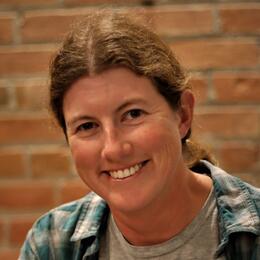Another entry in Abby's Birdbrained Summer. Abby, the summer communication intern for the Coast Office of Audubon North Carolina, is visiting sites with Audubon's field staff and our community of volunteers. After she goes into the field, she'll post blogs detailing her experiences.
My first experience in the field as an Audubon intern was following bio-technician Tara McIver as she monitored Lea-Hutaff Island. Lea-Hutaff is an approximately four mile long barrier island situated between Figure Eight Island and Topsail. It's also an IBA for nesting and migrating shorebirds.
Every other day, Tara walks up and down its length to find and monitor the nests of Least Terns and American Oystercatchers. The walk is no leisurely stroll—Tara lost twenty pounds last summer from the daily treks. She boats to the island at dawn so the sun won’t cook the eggs when the birds leave their nests during her checks. On the day I followed Tara, we visited the Least Tern colony on the north end of the island first.
As soon as we ducked under the line surrounding the nesting site, the expecting parents flew off their nests and piped their protests. I was slightly intimidated by the hundred yellow beaks whizzing above me, but there was no need for alarm. Tara related that the Least Terns are not aggressive, but it is safer to wear a helmet if you are going to upset Common Terns. The Least Terns lay their speckled eggs in small indentations in the sand. Their scrapes, nests sans eggs, are shallower than footprints on the beach. The birds prefer areas interspersed with shells for increased camouflage.
Since the end of April, Tara has found over 40 Least Tern nests containing one to three eggs, but the chance of survival is low. Raccoons and ghost crabs may eat the eggs, but nature is equally severe. Wind can cover the eggs with sand, and their semi-permeable shells can be drowned by rainfall. Tara said that a lunar tide wiped out almost an entire colony of nests last year. We checked on the nests Tara had already documented and marked new nests with numbered orange popsicle sticks. Then we focused on American Oystercatchers.
Oystercatchers are not as communal as Least Terns. An oystercatcher pair claims a territory, and does not leave that area for the four weeks it takes to incubate the eggs. If a nest fails, they may re-nest. Several pairs had already failed twice when I shadowed Tara. There are 26 oystercatcher pairs on Lea-Hutaff, and they have as diverse characters as humans. Some like shells in their scrapes, others prefer sand. Many parents circled overhead when their nests were interrupted, but others flew as far as possible from the nest to avoid its detection. American Oystercatcher eggs are roughly the size and shape of chicken eggs, but are covered in dark speckles. One pair left a trail of footprints leading right to their nest. The birds watched uneasily as Tara programmed the coordinates of the nest into her GPS, documented the distance from the nest to the nearest foliage, and measured the distance from the nest to the Atlantic shoreline. We found three new nests for a total of twenty oystercatcher nests so far this year. Unfortunately, only seven are active. The others have failed.
An oystercatcher's view from the Auditorium, looking east from the end of Hutaff Island from an early-April scrape. By Lindsay Addison
Although the Least Terns and oystercatchers generally prefer to nest in areas sheltered by dunes, a large number of birds nested in an area of Lea-Hutaff that Tara refers to as the "Auditorium." The Auditorium is on the southeast side of Lea-Hutaff, and the birds have a perfect waterfront view. The area is covered in scrapes and nests of Least Terns, Willets, and American Oystercatchers. I had to step very carefully to ensure I did not disrupt any well-camouflaged eggs. Tara found this year’s first oystercatcher nest in the Auditorium, and if everything goes well, the eggs should hatch soon.




